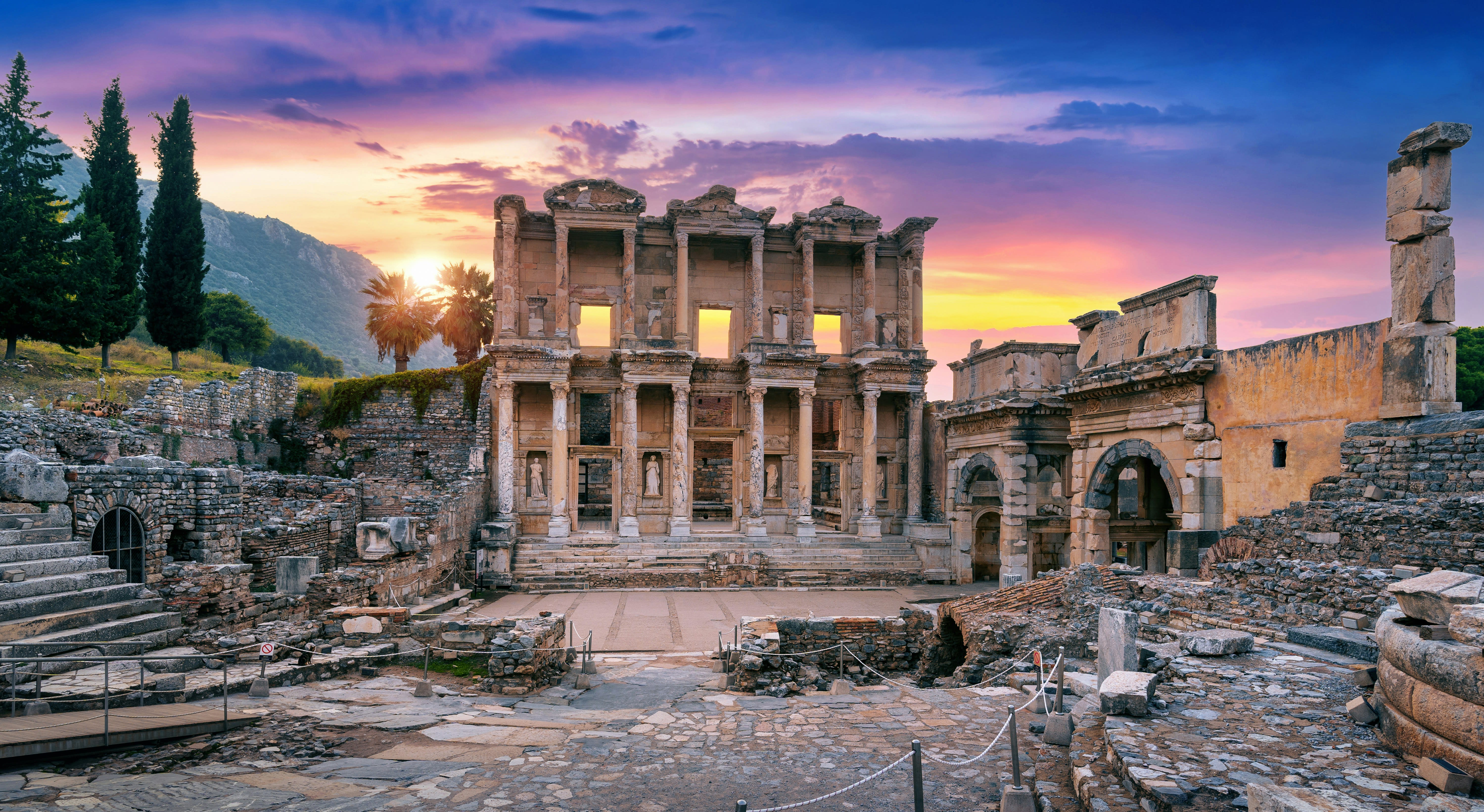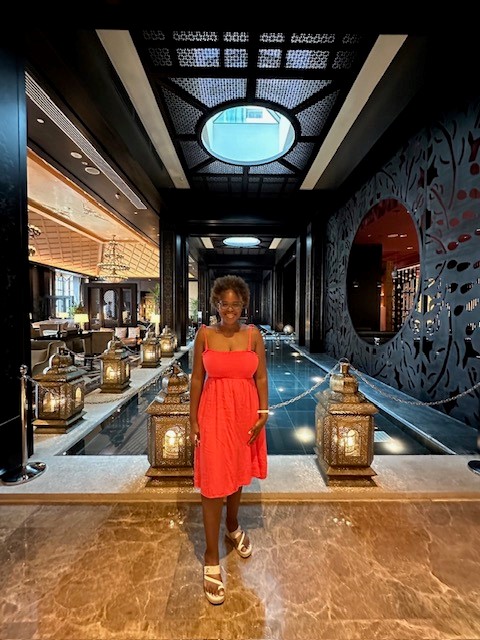
Curator’s statement
Traveling to Asia Minor of old was a dream come true for me. From meandering the streets and markets of Istanbul, to seeing the awe-inspiring rock formations of Cappadocia. Visiting the ancient city of Ephesus was an experience I will never forget. It was all other-worldly.
The Fora Difference
Book with Rene to access exclusive perks and experiences on your trip.
Killer perks
Free upgrades, spa credits and more—we got you
Personalized recs
Customized travel planning for your style
Insider knowledge
Expert advice from people who’ve actually been there
Where to stay
Unlock perks by contacting Rene to book your trip.
Day 1-3: Istanbul – Where East meets West

Start your Turkish adventure in Istanbul, a city that has been the capital of empires and the meeting point of continents.
Highlights
Aya Sofya Mosque: Considered the greatest work of Byzantine Architecture. For almost a thousand years, starting from its completion in 537, it was the world’s largest and most important religious monument. Emperor Justinian’s goal was to impress observers with its magnificent dome. When Mehmet II conquered Istanbul in 1453, he ordered the church to be converted into a mosque. The mosaics were plastered over, per Islamic tradition, but recent restoration efforts have uncovered many.
The Blue Mosque (Sultan Ahmet Mosque): Built from 1609 to 1617. It derives its name not from the color of its domes but from the 20,000 Iznik tiles interspersed with 260 stained-glass windows, calligraphy and intricate floral paintings. The architect, Mehmet Ağa, got carried away and surrounded this beautiful structure with six minarets linking it to the Masjid al-Haram in Mecca. This could not be permitted, so Sultan Ahmet sent Mehmet Ağa to the Holy City to add a seventh minaret to al-Haram, thus reestablishing its eminence.
Topkapi Palace & Harem: The power hub of the Ottoman Empire. It was built between 1459 and 1465 by Sultan Mehmet II. It can be compared to Versailles culturally, historically and politically.Don’t miss the Harem, where the Sultan’s courtesans (mostly Circassian women’s from the Caucasus as Muslim women were forbidden to be concubines) and Black eunuchs once lived. The harem housed 1,000 women.
The Grand Bazaar & Egyptian Spice Bazaar: A shopper’s paradise! Be ready to haggle and maybe even come out with a Turkish carpet or camel leather bag you hadn’t planned on buying, like I did.
Dining
Antakaya: Enjoy a delicious baked hummus and meat appetizer, followed by döner kebab and a mixed meat pastry. Pair it with a light-bodied Turkish Merlot.
Garden 1897: Though my meal was disappointing, the customer service was impeccable. If you visit, maybe go for their Turkish tea and baklava instead!
Mivar Restaurant Café: Try the lamb ribs with BBQ sauce — a unique but tasty dish
Day 4-6: Cappadocia – Fairy chimneys & underground cities

I don't recommend the hotel, though the neighborhood, Muhsine Hatun, was vibrant all day and all night long.
A flight from Istanbul takes you to the otherworldly landscapes of Cappadocia, famous for its fairy chimneys, cave dwellings and hot air balloon rides.
Highlights
Goreme Open Air Museum: UNESCO World Heritage site, home to rock-hewn churches with Byzantine frescoes. The is a panoramic view with breathtaking views of the fairy rocks and stunning views of the village of Goreme. The fairy chimneys of Göreme were first formed due to a series of volcanic eruptions that occurred millions of years ago in the Cappadocian region of Turkey. The region was once covered in thick layers of volcanic ash, which eventually solidified into a soft rock known as tuff.
Devrent Valley: Also known as the the Imagination Valley. There are a lot of different shaped rocks that look like various things such as camels, a snail, a penguin, etc.
Zelve Open Air Museum: A large cave settlement that dates back to the 9th century. It was equipped with a wine production area and a mill for grinding grains. The Christens who lived here had everything they needed to sustain themselves and then some. Delve remained a Turkish village until the 1960s. It’s often mentioned as one of the earliest centers where Christianity began to spread and even had the first seminaries for priests.
Uçhisar Castle: It is the highest fairy chimney,in Capadocia. Being visible for miles around, in the olden days, the Cappadocian castle gave residents views over surrounding landscapes so they could see any armies invading. The castle was used as a fortress during Byzantine and Ottoman times. About 1,000 people lived in its rooms and tunnels until the 1960s
Derinkuyu Underground City: There are hundreds of these cities in Capadoccia, but this is the deepest at 279 feet. Derinkuyu was thought to be the home of 20,000 people. Each family had their own quarters and there were common areas such as kitchens, stables and even a morgue. This underground city served as refuge off and on from 370 B.C. to its inhabitants (usually Christians fleeing different persecutors) through the 20th century.
Ihlara Valley: A 10-mile-long gorge that cuts its way through volcanic rock. It was created after several eruptions of the nearby Mount Erciyes. From the 7th century AD, Byzantine monks who dug their houses and churches out of the tuff stone settled the valley. Later, Christians fled and sought shelter in the caves.
Monks Valley (Pasabag): Where Byzantine monks carved homes and churches into soft volcanic rock.
Pigeon Valley: Pigeons played an important role in ancient times. They were used to carry messages. Their excrement was used for fertilizer, and their egg yolk was used to coat frescoes. You can see some of the pigeon homes (dovecotes, though I would be inclined to call them pigeon cotes).
Love Valley: One of the region’s most unique landscapes, famous for its tall, naturally sculpted rock formations that bear an unmistakable resemblance to phallic shapes. These towering stone pillars, some reaching up to 100 feet (30 meters) high, are the result of millennia of erosion.
Selime Monastery: The largest castle monastery in the region. Selime Cathedral was built in the 8th century C.E. Carved into the rocks, the monastery was used both as a place of worship and as a fortress against attacks. It includes a vast kitchen with a soaring chimney, three churches, stables with rock-carved feed troughs and other evidence of a troglodyte lifestyle.
Dining
Seten Restaurant: Nestled on a cave-top, where I had authentic Cappadocian dishes like fried meatballs and lamb shank, paired with a local Turkish wine.
Ravioli’s Turkish Restaurant: A must-try for Avcı Böreği (savory pastry), meatballs in a clay pot and Turkish ravioli.
Day 7-8: Izmir – Ancient Smyrna & Modern Comforts

After a short flight to Izmir, enjoy the perfect blend of ancient ruins and modern luxury.
Highlights
Izmir (Ancient Smyrna): A city mentioned in Revelation 1:11 and 2:8, with a deep history dating back thousands of years.
Dining
Boğaziçi Restaurant: I had their famous meatball pies stuffed with shredded beef, cheese and peppers, followed by succulent lamb ribs and Turkish house wine.
Hotel Restaurant (İzmir): Simple but delicious beef schnitzel, fries and Turkish rosé – one of the best meals of the trip!
Day trips
Take a day trip from Izmir to Ephesus, one of the best-preserved ancient Roman cities in the world.
Ephesus: Walking through ancient history
I was in awe during my visit to Ephesus, the city of the gods. Ephesus was a bustling port of call centuries before the Christian era. It was home to upwards of 500,000 inhabitants. It had all that its citizens and numerous visitors could desire, such as baths, brothels, theaters, temples, public latrines and one of the world’s largest libraries.
In pre-Hellenic times, it was the center of worship to the Anatolian goddess of fertility, Cybele. When the Ionians arrived, she was replaced with their patron goddess Artemis. A large temple was built in her honor, which was so grandiose. It was one of the seven wonders of the ancient world.
During Roman times, Ephesus was second to Rome in number of inhabitants and had all of the conveniences of a metropolis of its time. Not only did Apostle Paul address a letter to the first-century Christians living in this city, but he also visited Ephesus during his second missionary visit in 52 C.E. and returned during his third trip.
Library of Celsus: Once one of the largest libraries in the ancient world.
Theater of Ephesus: Could seat 25,000 spectators and is still used for concerts today.
Temple of Artemis: Once one of the Seven Wonders of the Ancient World.
House of the Virgin Mary: A pilgrimage site believed to be where Mary spent her final years.

Travel Advisor
Rene Little

Get in touch with Rene
Did you like this guide? Reach out to customize and book your own experience. Or, just to chat about travel in general.
You can normally expect a response from Rene within a business day or so. You’ll also be subscribed to our travel newsletter (you can unsubscribe at any time).
For more inspiration and insider recommendations, visit our Türkiye page.